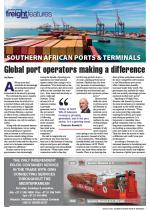Ports in South Africa, more than anywhere else in the world, will see the highest risk increase because of climate change compared to any other region globally, says Jasper Verschuur, lead researcher at Oxford University’s Environmental Change Institute (ECI).This is despite the fact that present-day risk in Sub-Saharan Africa (SSA) ports is relatively low, a recent ECI study into meteorological, hydrological and geophysical disasters and disruption has found.Although it’s good news for the region overall, South Africa has drawn a short straw in climate turns.“We see that ports in SSA are less exposed to natural disasters than ports elsewhere in the world, except for South Africa, where there are still threats from multiple disasters affecting port infrastructure and operations.”SA most high-risk area in SSAWith the exception of cyclones that blow in from the east across the Indian Ocean, often dumping torrential weather and devastation on Mozambican ports like Beira, South Africa remained the highest-risk area in SSA for storm surges, Verschuur said.“Hot spots” he referred to include “lower-lying port terminals along rivers or ports in South Africa”.He said: “Durban and Port Elizabeth (Gqeberha) are quite exposed to extreme waves.”Durban, of all the ports within the SSA region, remained the most risk-heavy port in terms of climatological data assessed by the ECI, Verschuur said.He added that it was encouraging to see measures had been taken by ports like Durban and Port Elizabeth to cope with weather events, especially through the use of tug boats and piloting vessels that can work under heavy waves.However, Verschuur is cautiously optimistic about the ability of ports to weather unexpected storms.He said: “What is also important to consider for a lot of SSA ports is that although port terminals are quite elevated, they often depend on a few main roads or railway lines that can be prone to disaster impacts.“These can affect operations without affecting the port itself. The f looding in Durban (in April 2021) was a perfect example of that.”Fundamental improvement in port planning crucialMany of the recent findings by the ECI highlight the need for fundamental improvements at the executive level of port planning and management.Without these improvements, ports in high-risk areas like Durban may find it increasingly difficult not only to absorb storm blasts, but also to bounce back from extreme weather.Verschuur stressed that “ports will need to adapt to this or expect more damages or more frequent downtime”.In addition to the change-management improvements required to safeguard ports, he also touched on the necessity for stepped-up design thinking to make disaster-prone ports more robust.“There is a great opportunity for new expansions to factor in climate change upfront, which we expect to be at relatively low cost compared to upfront investment costs.“We recommend, and are starting to work with some organisations which I cannot name at present, that future climate risks are explicitly considered when designing a new port.”Looking at the wider global picture, the ECI’s study found that of the 1 340 most important ports in the world, at least 87% are dangerously exposed to potential sudden weather calamities.These are ports like Houston and Shanghai as well as Antwerp and Rotterdam, all inside the three respective high-risk regions identified by the ECI: the Gulf of Mexico, Asia, and Western Europe.What’s concerning though is South Africa’s ability to properly run what is currently on offer by local ports.Sudden blip causes supply chain chaosTenuously managed at best, it takes a sudden blip of increased throughput to cause havoc.One only needs to consider the waiting-time chaos that resulted from the implementation of a truck-staging area at the Port of Cape Town.The arbitrary manner in which transporters were treated had the exact opposite effect to Transnet’s initial objective – alleviating congestion.Although South African ports could certainly do with hifalutin concepts like change-management and improved design-thinking, we actually need a new brains trust that addresses some of the ongoing challenges experienced in the port sector that continue to hamper imports and exports.

